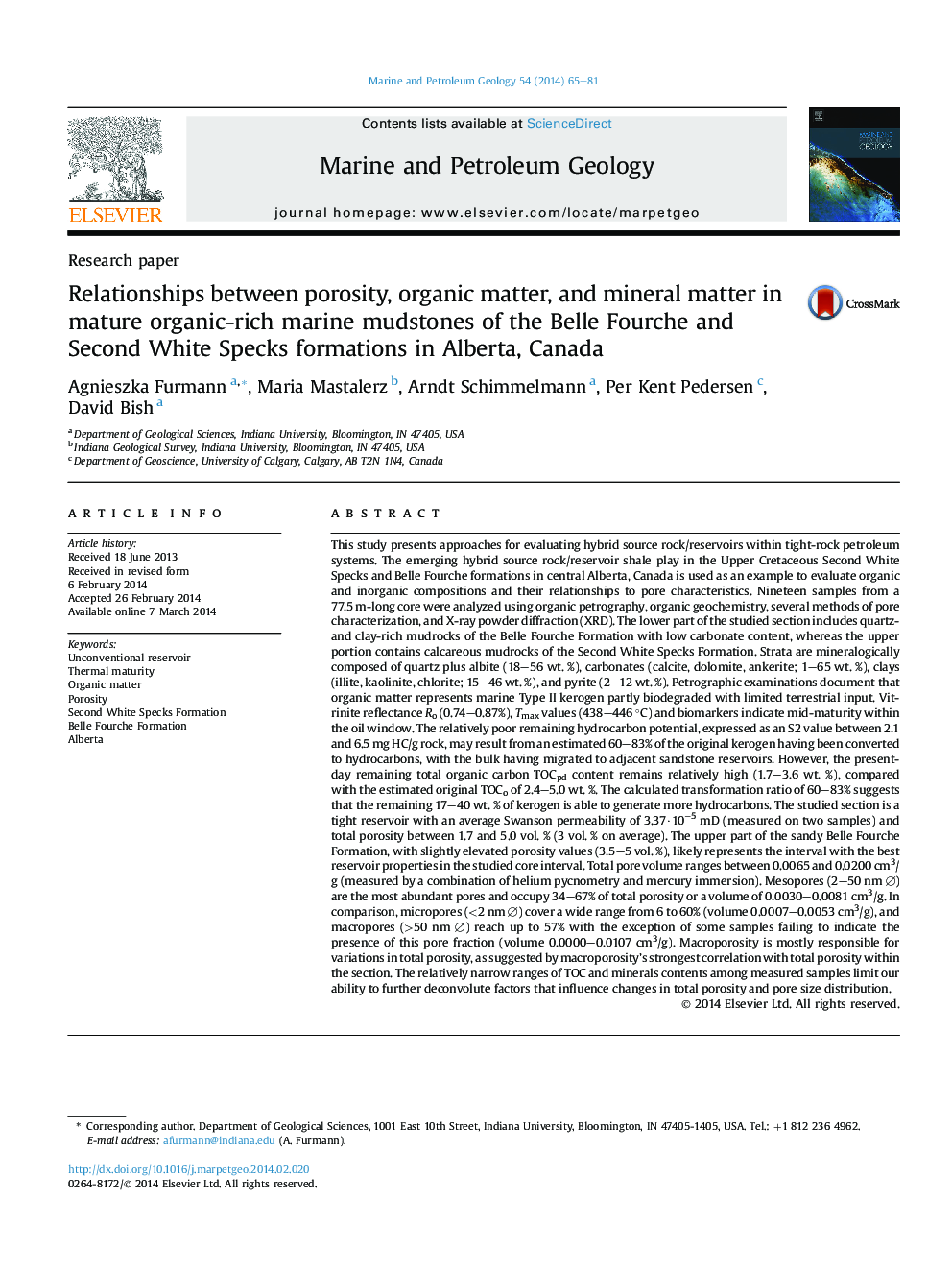| کد مقاله | کد نشریه | سال انتشار | مقاله انگلیسی | نسخه تمام متن |
|---|---|---|---|---|
| 4695575 | 1637170 | 2014 | 17 صفحه PDF | دانلود رایگان |

• Source rock/reservoir potential of two formations in Alberta was evaluated.
• Total porosity ranges from 2 to 5 vol. % (total pore volume 0.0065–0.0200 cm3/g).
• Total pore volume has better correlation with macropores than micro- and mesopores.
• Organic matter and clay minerals contribute to the micropore volume.
• Quartz, feldspar, and clay minerals are likely contributors of mesopores.
This study presents approaches for evaluating hybrid source rock/reservoirs within tight-rock petroleum systems. The emerging hybrid source rock/reservoir shale play in the Upper Cretaceous Second White Specks and Belle Fourche formations in central Alberta, Canada is used as an example to evaluate organic and inorganic compositions and their relationships to pore characteristics. Nineteen samples from a 77.5 m-long core were analyzed using organic petrography, organic geochemistry, several methods of pore characterization, and X-ray powder diffraction (XRD). The lower part of the studied section includes quartz- and clay-rich mudrocks of the Belle Fourche Formation with low carbonate content, whereas the upper portion contains calcareous mudrocks of the Second White Specks Formation. Strata are mineralogically composed of quartz plus albite (18–56 wt. %), carbonates (calcite, dolomite, ankerite; 1–65 wt. %), clays (illite, kaolinite, chlorite; 15–46 wt. %), and pyrite (2–12 wt. %). Petrographic examinations document that organic matter represents marine Type II kerogen partly biodegraded with limited terrestrial input. Vitrinite reflectance Ro (0.74–0.87%), Tmax values (438–446 °C) and biomarkers indicate mid-maturity within the oil window. The relatively poor remaining hydrocarbon potential, expressed as an S2 value between 2.1 and 6.5 mg HC/g rock, may result from an estimated 60–83% of the original kerogen having been converted to hydrocarbons, with the bulk having migrated to adjacent sandstone reservoirs. However, the present-day remaining total organic carbon TOCpd content remains relatively high (1.7–3.6 wt. %), compared with the estimated original TOCo of 2.4–5.0 wt. %. The calculated transformation ratio of 60–83% suggests that the remaining 17–40 wt. % of kerogen is able to generate more hydrocarbons. The studied section is a tight reservoir with an average Swanson permeability of 3.37·10−5 mD (measured on two samples) and total porosity between 1.7 and 5.0 vol. % (3 vol. % on average). The upper part of the sandy Belle Fourche Formation, with slightly elevated porosity values (3.5–5 vol. %), likely represents the interval with the best reservoir properties in the studied core interval. Total pore volume ranges between 0.0065 and 0.0200 cm3/g (measured by a combination of helium pycnometry and mercury immersion). Mesopores (2–50 nm ∅) are the most abundant pores and occupy 34–67% of total porosity or a volume of 0.0030–0.0081 cm3/g. In comparison, micropores (<2 nm ∅) cover a wide range from 6 to 60% (volume 0.0007–0.0053 cm3/g), and macropores (>50 nm ∅) reach up to 57% with the exception of some samples failing to indicate the presence of this pore fraction (volume 0.0000–0.0107 cm3/g). Macroporosity is mostly responsible for variations in total porosity, as suggested by macroporosity's strongest correlation with total porosity within the section. The relatively narrow ranges of TOC and minerals contents among measured samples limit our ability to further deconvolute factors that influence changes in total porosity and pore size distribution.
Journal: Marine and Petroleum Geology - Volume 54, June 2014, Pages 65–81